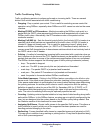
Configuration Examples
516
ProSafe M5300 Switch
Traffic Conditioning Policy
Traffic conditioning pertains to actions performed on incoming traffic. There are several
distinct QoS actions associated with traffic conditioning:
• Dropping - Drop a packet upon arrival. This is useful for emulating access control list
operation using DiffServ, especially when DiffServ and ACL cannot co-exist on the same
interface.
• Marking IP DSCP or IP Precedence - Marking/re-marking the DiffServ code point in a
packet with the DSCP value representing the service level associated with a particular
DiffServ traffic class. Alternatively, the IP Precedence value of the packet can be
marked/re-marked.
• Marking CoS (802.1p) - Sets the three-bit priority field in the first/only 802.1p header to a
specified value when packets are transmitted for the traffic class. An 802.1p header is
inserted if it does not already exist. This is useful for assigning a layer 2 priority level
based on a DiffServ forwarding class (i.e., DSCP or IP Precedence value) definition to
convey some QoS characteristics to downstream switches which do not routinely look at
the DSCP value in the IP header.
• Policing - A method of constraining incoming traffic associated with a particular class so
that it conforms to the terms of the TCS. Special treatment can be applied to out-of-profile
packets that are either in excess of the conformance specification or are non-conformant.
The DiffServ feature supports the following types of traffic policing treatments (actions):
• drop - The packet is dropped
• mark cos - The 802.1p user priority bits are (re)marked and forwarded
• mark dscp - The packet DSCP is (re)marked and forwarded
• mark prec - The packet IP Precedence is (re)marked and forwarded
• send: the packet is forwarded without DiffServ modification
Color Mode Awareness - Policing in the DiffServ feature uses either color blind or color
aware mode. Color blind mode ignores the coloration (marking) of the incoming packet.
Color aware mode takes into consideration the current packet marking when determining
the policing outcome. An auxiliary traffic class is used in conjunction with the policing
definition to specify a value for one of the 802.1p, Secondary 802.1p, IP DSCP, or IP
Precedence fields designating the incoming color value to be used as the conforming
color. The color of exceeding traffic may be optionally specified as well.
• Counting - Updating octet and packet statistics to keep track of data handling along traffic
paths within DiffServ. In this DiffServ feature, counters are not explicitly configured by the
user, but are designed into the system based on the DiffServ policy being created. See
the Statistics section of this document for more details.
• Assigning QoS Queue - Directs traffic stream to the specified QoS queue. This allows a
traffic classifier to specify which one of the supported hardware queues are used for
handling packets belonging to the class.
• Redirecting - Forces classified traffic stream to a specified egress port (physical or LAG).
This can occur in addition to any marking or policing action. It may also be specified along
with a QoS queue assignment.


















